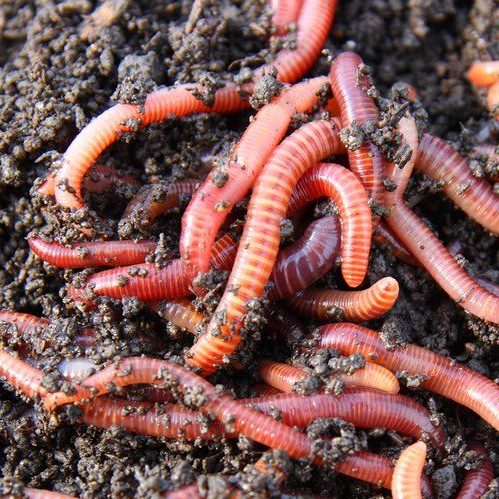Red Wigglers: The Unsung Heroes of Organic Waste Recycling
Red wigglers, or Eisenia fetida, offer as critical agents in the organic waste reusing process, changing discarded materials right into important vermicompost. As the world increasingly seeks solutions to battle waste build-up and improve farming performance, recognizing the function of these worms becomes crucial.
What Are Red Wigglers?
The impressive durability of red wigglers, scientifically recognized as Eisenia fetida, underscores their essential duty in organic waste recycling. These tiny, reddish-brown earthworms are commonly located in disintegrating raw material, such as compost heaps and manure heaps. Lake Hickory Bait. Unlike various other earthworm species, red wigglers prosper in nutrient-rich atmospheres and are very reliable at breaking down natural products, making them important for vermicomposting

(Red Wiggler Express)In addition to their role in waste reduction, red wigglers add to soil wellness by improving dirt structure and oygenation with their delving tasks (Lake Hickory Bait). Their visibility in composting systems not just boosts decay rates yet likewise promotes a lasting approach to waste management, illustrating their significance in ecological preservation initiatives
Benefits of Composting With Worms
Composting with worms, specifically red wigglers, offers many advantages that enhance both waste administration and dirt health and wellness. Initially, these worms efficiently damage down natural waste, transforming it into nutrient-rich vermicompost that enhances dirt. This process speeds up decay, allowing for a much faster recycling of kitchen area scraps and various other organic products compared to conventional composting approaches.
Additionally, the vermicompost created by red wigglers is including beneficial microbes, which help boost dirt framework, oygenation, and moisture retention. This enhances the total health of plants, promoting energetic growth and raised yields in yards and agricultural setups. The use of worms in composting lessens the manufacturing of greenhouse gases, such as methane, adding to an extra sustainable waste management system.

Just How to Start Vermicomposting
Establishing a vermicomposting system is a simple procedure that can generate significant benefits for both waste administration and dirt enrichment. To begin, select an ideal container, such as a plastic container or wooden box, with adequate ventilation openings to ensure proper airflow. The dimensions must preferably be about 2 feet by 3 feet, permitting enough space for the worms to flourish.
Following, prepare bedding product, which can contain shredded newspaper, cardboard, or coconut coir. This bedding needs to be moistened to develop an ideal environment for the worms. Once the bedding is in place, introduce red wigglers (Eisenia fetida) right into the container, commonly around one extra pound of worms for every square foot of surface location.
Adhering to the positioning of worms, add organic waste, such as vegetables and fruit scraps, coffee premises, and smashed eggshells. Stay clear of adding milk, meat, or oils, as these can produce smells and draw in parasites. Finally, position the bin in a shaded, temperature-controlled area to maintain optimum conditions for worm task. With these actions, you will successfully start a vermicomposting system that adds to lasting waste management and enriches your soil.
Keeping a Healthy Worm Bin
(Red Wiggler Express)Maintaining a worm container thriving calls for normal focus and treatment to ensure the health of the red wigglers and the efficiency of the composting procedure. Appropriate maintenance starts with keeping track of the moisture degrees; the bin should be wet however not waterlogged. A great policy of thumb is to preserve a consistency comparable to a wrung-out sponge.
Carefully mixing the bed linens and food scraps every few weeks protects against compaction and makes certain that all worms have accessibility to oxygen. Furthermore, it is important to feed the worms suitably.
If the container comes to be also warm or cool, the worms may come to be worried. By vigilantly managing these elements, one can maintain a robust and efficient worm container.
Influence On Lasting Living
The successful maintenance of a worm container Lake Hickory Bait not just benefits the health of red wigglers yet likewise adds considerably to lasting living practices. By reusing organic waste, such as kitchen area scraps and lawn debris, red wigglers aid draw away considerable amounts of material from garbage dumps. This decrease in waste not only decreases greenhouse gas emissions but additionally lessens the ecological worry related to waste management.
Furthermore, the castings created by red wigglers work as a nutrient-rich natural plant food, improving dirt health and advertising plant development. This natural choice to chemical fertilizers sustains sustainable farming and horticulture techniques, reducing dependence on synthetic inputs that can harm ecosystems. Furthermore, worm composting promotes understanding of waste administration, motivating individuals and neighborhoods to adopt more sustainable habits.

Verdict
In recap, red wigglers work as important factors to organic waste recycling with their reliable decay of natural materials. Their ability to generate nutrient-rich vermicompost improves dirt wellness and sustains lasting agricultural methods. By integrating vermicomposting right into waste administration techniques, individuals and neighborhoods can dramatically decrease waste while advertising environmental sustainability. The role of Eisenia fetida in cultivating healthy and balanced ecosystems highlights the importance of these organisms in attaining lasting living and improving dirt fertility.